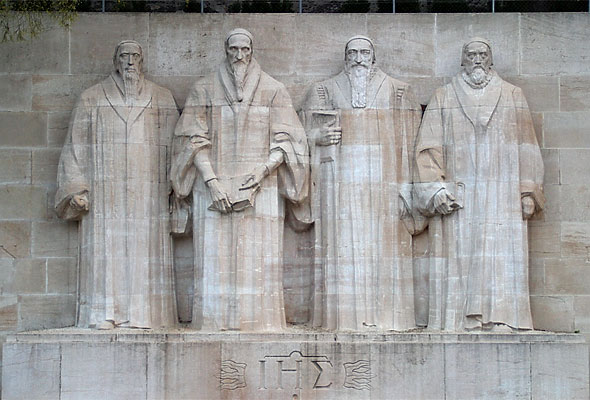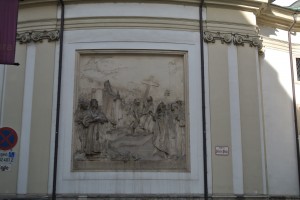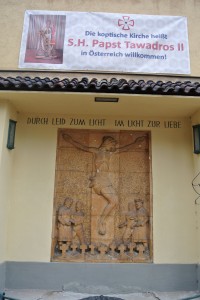I do have a habit of tap-dancing on the risky rail. When I wrote this morning’s post I put in a line about the reformers cleaning the churches of images… but concentrating on the issue of syncretism. But Lucia, who writes a very good blog (NZ conservative, it’s linked) had some comments to add.
And it was something I was trying to avoid. In this time, when society is going rapidly pagan, we have to stand with our Christian Brothers and sisters, even though we disagree with them. The issue is one of iconoclasm: the breaking of idols, the shattering of statues.
I agree with you about the offensiveness of tapu and sacred land, but disagree that the (protestant?) reformers were motivated by the same thing.Statues are really just like pictures. We look at them and we think of the person. Some people will even talk to pictures with the knowledge that the picture itself is not the person but provides a reference point for that person. Prayer to a statue is kind of like that, except that given the person being prayed to is in Heaven, that person can really hear you when you speak to them.
I think the reformers were trying to get as far away from direct contact with those in Heaven as possible because what they did was to destroy connections, and who wants anyone watching them when they do that?
….God wants us to worship Him – not for anything He needs, of course – but for us, so we will understand the right order of us to Him, and more besides. God is more than just empty space as His Son made the Invisible God, visible. Human beings, too, need that visibility, that physicality. Otherwise, we wouldn’t have bodies.
I see the ikonoclastic controversy a symptom of the desire of people to just be spiritual and not material, or to consider the material evil in some way, as the Gnostics did.
I’ll always remember when my youngest son was 5, nearly 6, and I was desperate for him to have faith in Jesus and in the Church (my family are converts), and the thing that worked for him was going into a cathedral (St Mary’s in Sydney), and coming across an almost life size crucifix on the wall as we were walking all around the church, and stopping and touching the feet of Our Lord with the nails in them, and saying, “So this is what they did to Him”. Something happened at that point, and for a small child, it needed to be real for him to get it.

St Ahmet the NeoMartyr
So, we have a bas-relief on the outside of a church. I liked it: the photo was poor, but the bas-relief is big — and shows the passion of Christ. We have images of the martyrs (St Ahmet was converted when he witnessed the Orthodox communion in secret, and one day declaimed this to his Islamic colleagues, losing his life rapidly afterwards. He was a calligrapher.)
And the Protestants are not above making statues of their heroes either, this is from the Reformation wall and shows Beza, Calvin, Farel and Knox: the four founders of reformed theology.

So, as art, outside: even as an educational aid — no one argues. It is when it gets to these things behind seen themselves as sacred, worthy of veneration as objects that the iconoclastic streak comes out. (If you really want to make me fume, copyright that made by generations long dead as a public work of witness and devotion: do not allow recreation of work: do not allow us to discuss, critique, show, reinterpret. Copyright is a compromise we make so creators can be fed, not to allow corporations or heirs to rent the proceeds for generation after generation).
For Lucia misses with her suggestion that those who do not have these images are gnostics. We are not: we are, instead, cautious. We do not want any object to be venerated. We want God to be: we do not want to fall into the error Paul described as seeing the Glory of God in creation we worshipped the creation, and not God.
The following will offend the Catholics, but the reformers were completely against decoration, statues, stations, the rood screen, and special robes. Those robes that Calvin and his mates are in? Standard academic garb of the day. For a while, and in some churches, the congregation sat on all four sides of a central table, with but the word of God on it. Some of this was driven by envy, greed (that plate was melted and minted) and the sheer joy of destruction. But the reasons this winnowing of churches was suggested was not that. It was that the people of that time were venerating not God, and using the ikon or statue as a means to concentrate on God, but that they were worshiping the ikon or statue itself.
Not a denial of our humanness or frailty or fallen state. Calvin and Luther are far more bleak than Erasmus, who had a more positive view of humanity (and remained in a church which had sunk into deep corruption, requiring a council (Trent) to reform it). Not gnosticism. But idolatry.
There is, however, a useful side effect. On Sunday I attended a church, not in a beautiful building in Vienna (where I did sit in a Catholic Service, in German, because it was Sunday). But in a bowling club hall. Most weeks I go to church in a town hall. The congregation I am a member of is facing six figure bills to get its buildings strengthened to earthquake standards (for the non Kiwis reading this, NZ had a 6.2 Richter earthquake 600 miles from where I live today — did not feel it). The building may get in the way of us doing what we ought to: as time goes these buildings can change.
The photo above is interesting. I’m not sure if the church was originally Catholic, but that is the way to bet: it is Vienna after all. But the canvas image above is of a Coptic bishop. The church is now Coptic: the congregation is Egyptian, and the service inside (same Sunday) was monophysite. I went over and worshiped with the Papists with a sense of relief.
iconoclasm? Perhaps. I like icons: I like old churches, including baroque Catholic ones. I even like some new churches. But we need to be able to drop all of this. We are a bunch of pilgrims: we carry our faith in our heads, and we are preserved by the Spirit of God. In the end, this is a discussion that Christians will always have (and still have: organs were once newfangled, and among the evangelicals the tendency to build over elaborate buildings is as great as it was in the High Middle Ages with one caveat: the old buildings are beautiful. The new ones are generally ugly).
The plain and empty church, however, forced the congregation to concentrate on the spoken word, the preached word. Perhaps this has made us quite intense about the Bible: the reformed have frequently been accused of worshiping that book. Without icons, and often without written liturgy, one is forced to walk out, relying on the Spirit of God. (For those who have never seen it, this happens in an Open Brethren Service every week — and yes, I once was a member of such a congregation).
But… and this is a very big but: God has used liturgy, and statues, and images to proclaim his word. He has used animals and beauty. He has used preaching. He has used the death of ordinary folk like Ahmed the calligrapher. The Holy Spirit will use anything. It is that which stops me from going into the anti-papist rants my genetic and spiritual forefathers were in the habit of doing. Instead, if the gospel is proclaimed by a Papist, or a Russian Orthodox, or a Syrian… I will praise God. If by art, I will praise God. For I do not care how, but that the gospel is proclaimed.








